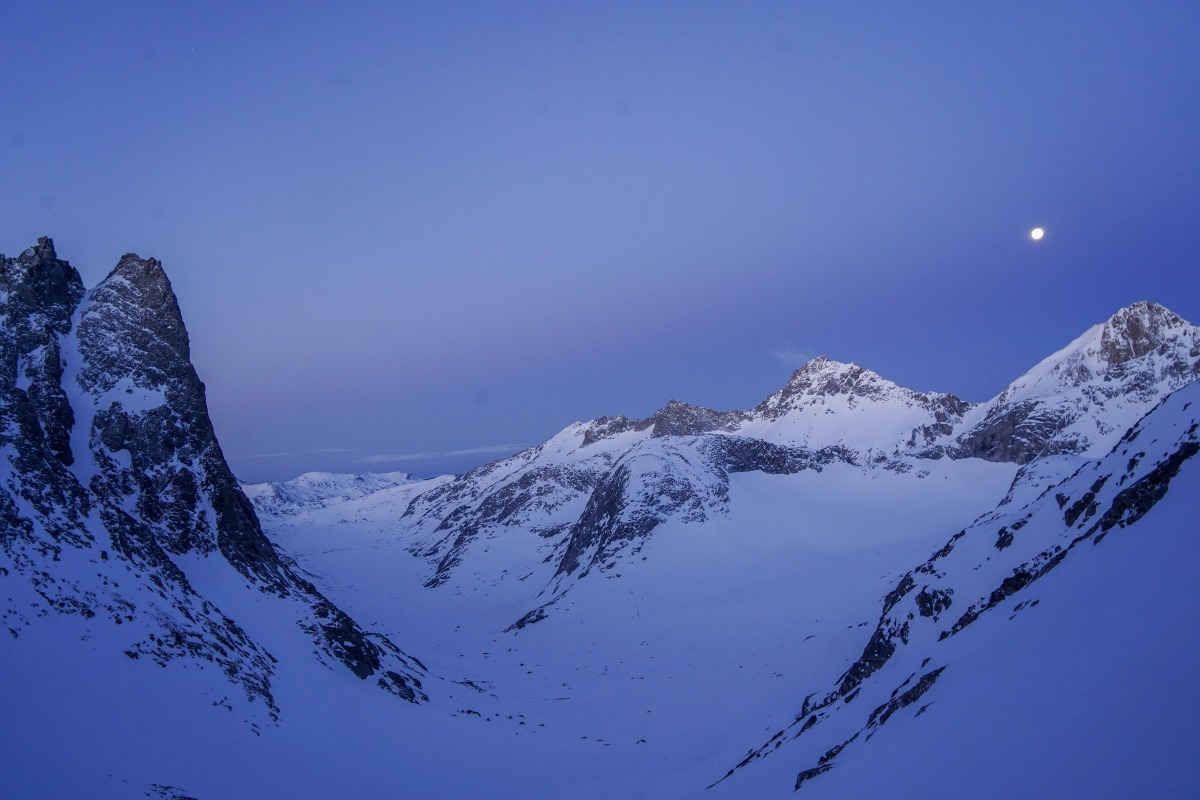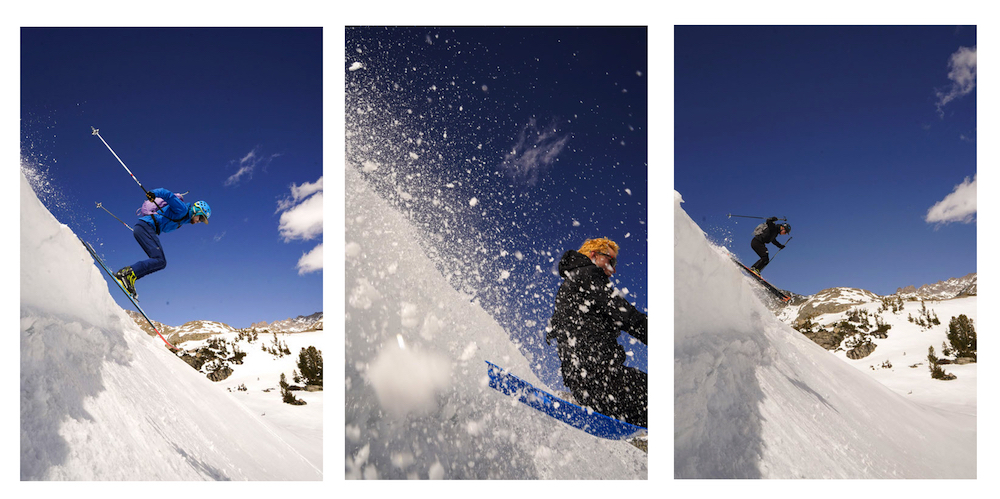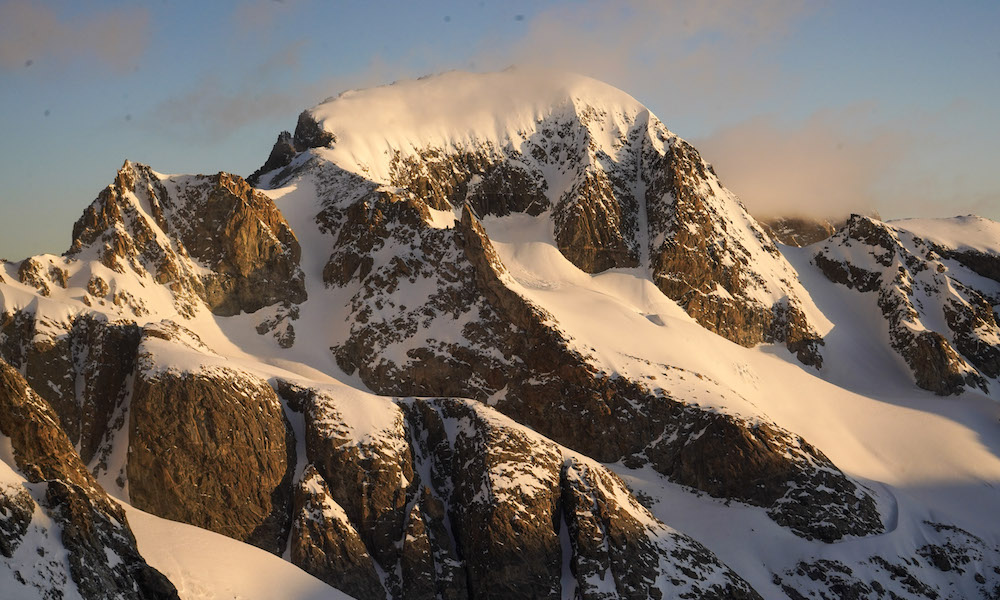
This was our first close-up view of Gannett Peak. We were able to inspect our ascent and descent, see the fresh coat of new snow, and generally gawk at the scale of the summit. (Photo: @morgankelsey)
A Low impact local ski mountaineering expedition
We were wrapping up a dinner of mac and cheese and sundried tomatoes (and extra cream cheese). My body craved the dense food after hours/days spent in constant motion. Gavin, Morgan and I sat outside the cook tent in a moment of stillness. We caught the evening light shine against the mountains. The granite faded through shades of yellow and orange and pink, and dusk settled into a deep purple.
My nose and cheeks radiated heat from days of clear skies and reflective snow. My eyes were teary from all of the bright light. My legs ached with a satisfying burn. It was our last night before returning home. The rest of the evening was spent sharing stories, swapping jokes, and savoring our time spent skiing in this remote place.
—
Pre: This past spring I connected with two close friends, Gavin and Morgan, to plan a ski trip. We worked great as a team in the past – having shared trips to Argentina, Western Europe, and the Tetons. This time, we wanted to ski in new, remote terrain while minimizing our cumulative travel time and impact. We chose to ski in the Bridger Wilderness, which had specific requirements in regards to backcountry etiquette, group size and required a backcountry permit. (All info was available on the US Forest Service website, which I recommend checking out if you’re planning a trip anywhere on public land)
Gavin, Morgan and I finalized our trip itinerary, packed our bags and sled, and drove to the trailhead together in one vehicle (to minimize trailhead congestion). The plan was to spend a day approaching through the woods until we reached the cirque that we intended to ski. Once established at camp, we would have three days to ski without any specific objectives in mind. Outside of that loose lack of a plan, we set one day aside for an attempt to ski Gannett Peak. But only if conditions, health, and psych allowed. Most important to us was to stay safe in such a remote location (as to not pull local resources for a far-flung backcountry rescue), leave the least impact possible on the surrounding terrain, and enjoy quality time together in the mountains.
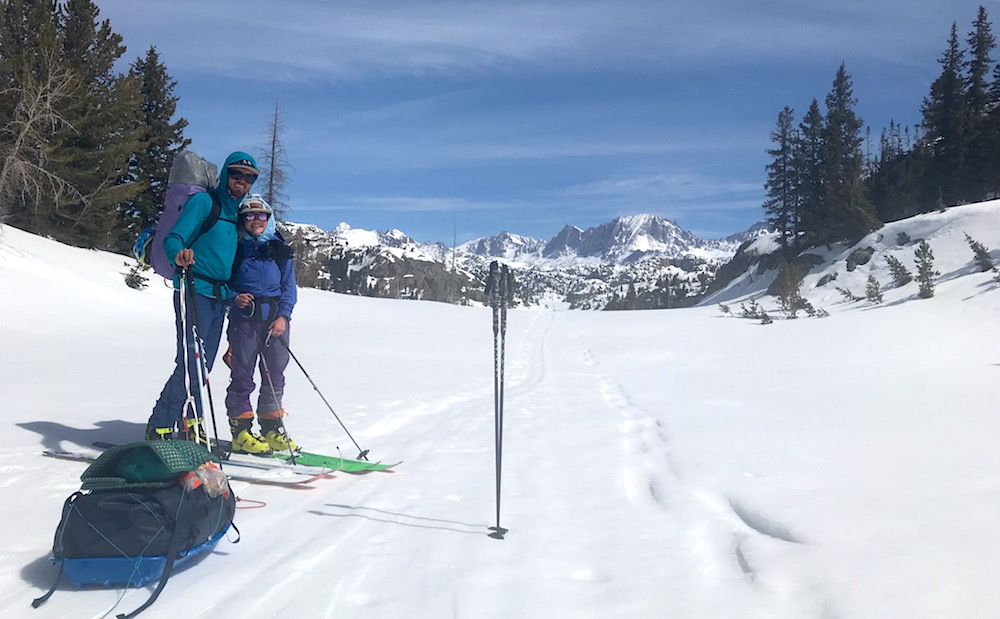
Gavin, Morgan, our sled (Pierre), and my poles stand in the foreground while the first glimpse of our final destination proudly present itself in the background
Day 1
Our approach to basecamp went swimmingly. We shared the task of hauling one sled that held our group gear (tents, cooking kit, and food). Otherwise, each of us carried a 30L pack holding personal gear. We wove through dense forest and passed a string of frozen lakes until our flat winding approach led us to the inlet of a lake. This would work great as a basecamp location. We were looking for the following criteria in particular:
— Proximity to running water, but 100′ away from both established trails and streams
— Protection from wind and inclement weather using natural terrain features
— Possibility for a basecamp booter to practice our budding freestyle skills
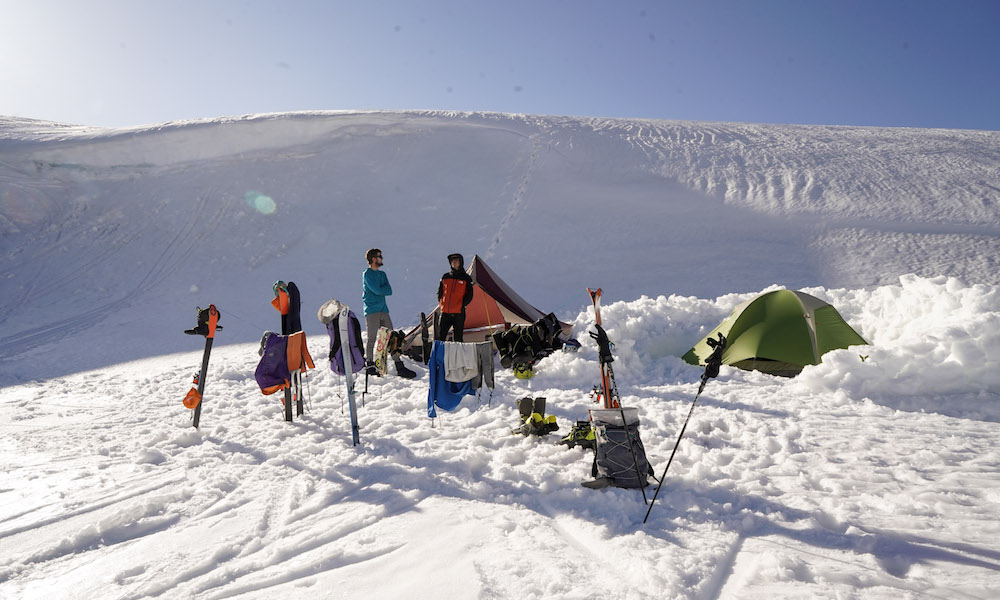
A photo of our final basecamp. Gear is drying on strung-out lines, water is boiling in the cooktent, the bootpack is set for cornice sledding, and a snow wall helps limit our exposure to the wind. An open stream is 200′ away from the camp, and the hill behind camp helps protect us from larger gusts of wind sweeping from across the lake.
The three of us had varying levels of winter camping experience and skiing from a backcountry basecamp. We hoped to dial in our systems like building a comfortable basecamp, clean and efficient backcountry cooking, managing prolonged exposure to the sun/wind/snow/each other, and on-sight skiing in new terrain. Our home for the next six days turned us to kids in a [alpine] candy shop: seeking safe skin track options while digging out the cook tent, drooling over couloirs during dinner, peeking out of the tent to see a silhouette of sharp granite summits, and falling asleep with dreams of tomorrow’s ski.
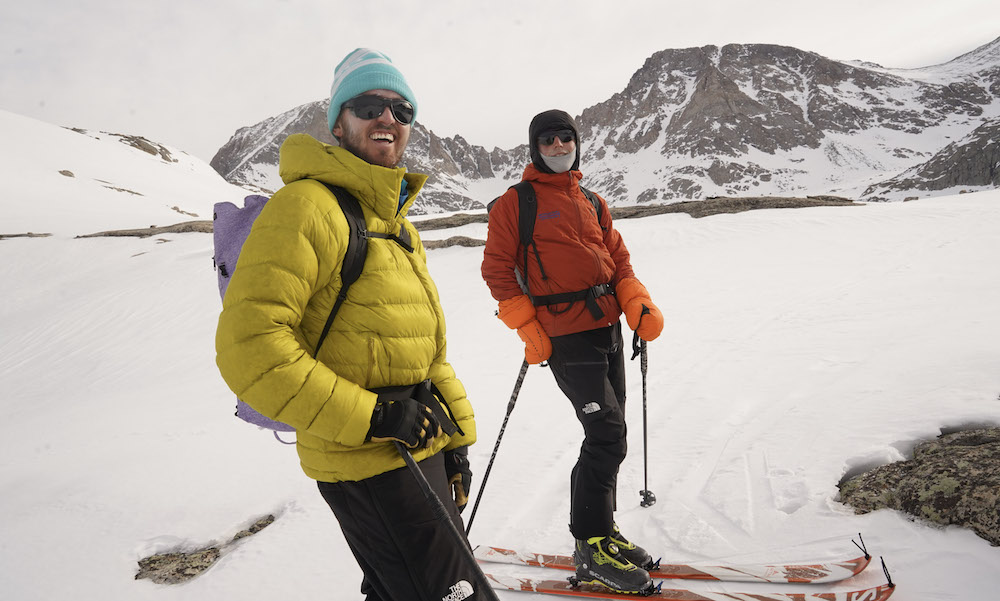
The first day consisted of gray skies that slowed the process of a spring freeze-thaw cycle. We were excited to poke around the local terrain and assess current snow conditions. Big smiles and big puffy coats were worn for the majority of the day. My hands get cold, so I was wearing hilariously big down mittens. (Photo: @morgankelsey)
Day 2
We woke up, brewed up, and skinned up for our first day of skiing. The goal for today was to collect information: What does the snow pack look like at various aspects and elevations? What do we expect to see/find? What are our main hazards and concerns? We built a hypothesis to test and went out to gather information to make our assessment of how we would handle skiing for the week.
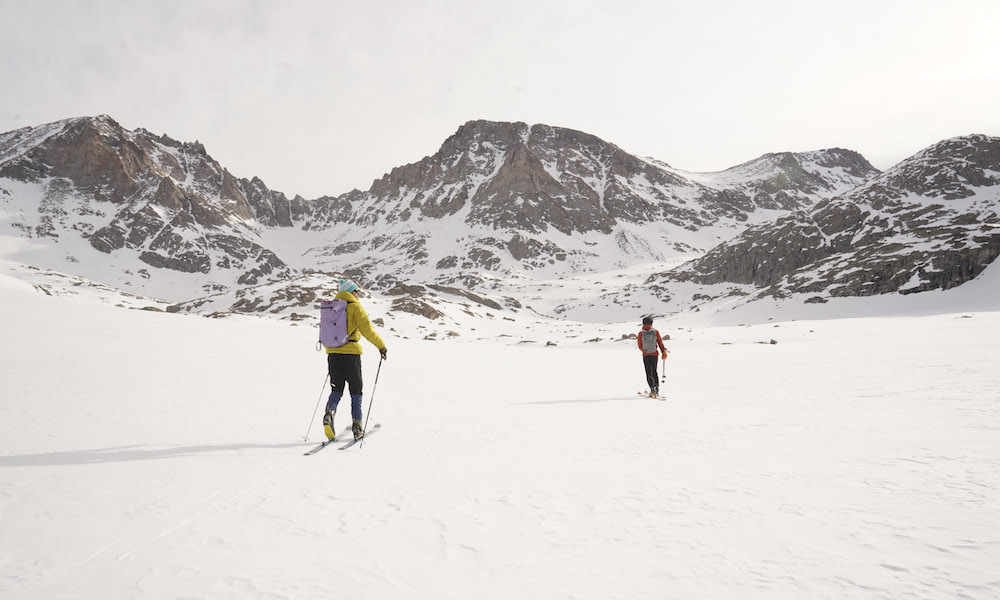
We’re touring the neighborhood, scouting prospective lines. Our final destination was the top of the peak on the left side of the frame. (Photo: @morgankelsey)
We skied a beautiful shot on a peak just east of camp. It looked fun from our cirque scouting, had a non-committing approach, and was close enough to return back to camp for a hot lunch. After lunch we went back to the same zone to ski a line across the valley from our aforementioned descent. Our kid-in-a-candy-store mentality was getting put into action. The late afternoon consisted of drying gear, eating chips, exchanging opinions of why skinny skis rock, and working on our raccoon tans. Slowly the light faded and we crawled into our tent with hopes for another day of great skiing.
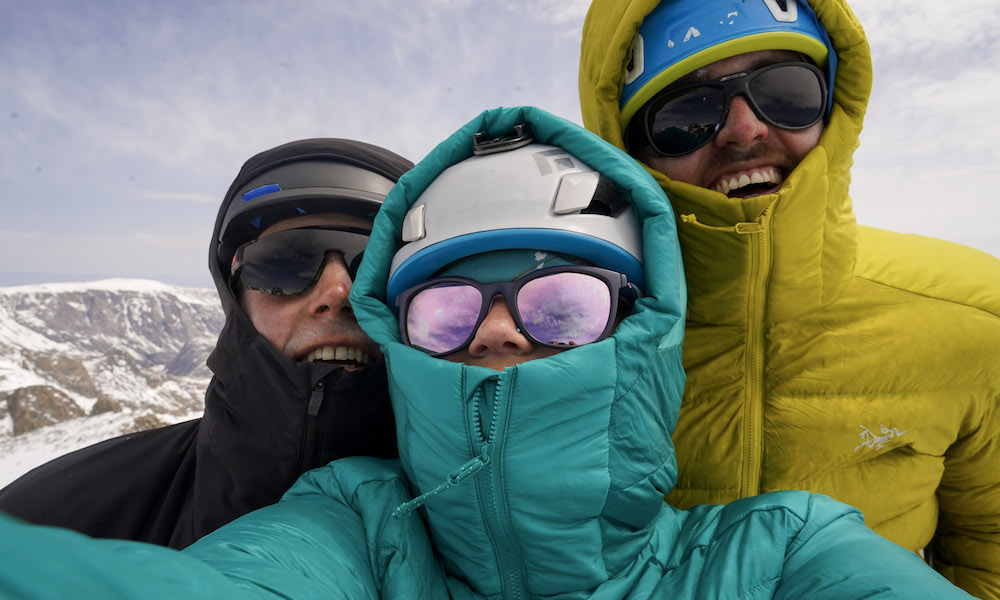
All smiles atop our first summit of the trip. It was cold and gusting, but the grey overcast was clearing. It kept us hopeful that the next few days would produce clearer, warmer weather. (Photo: @morgankelsey)
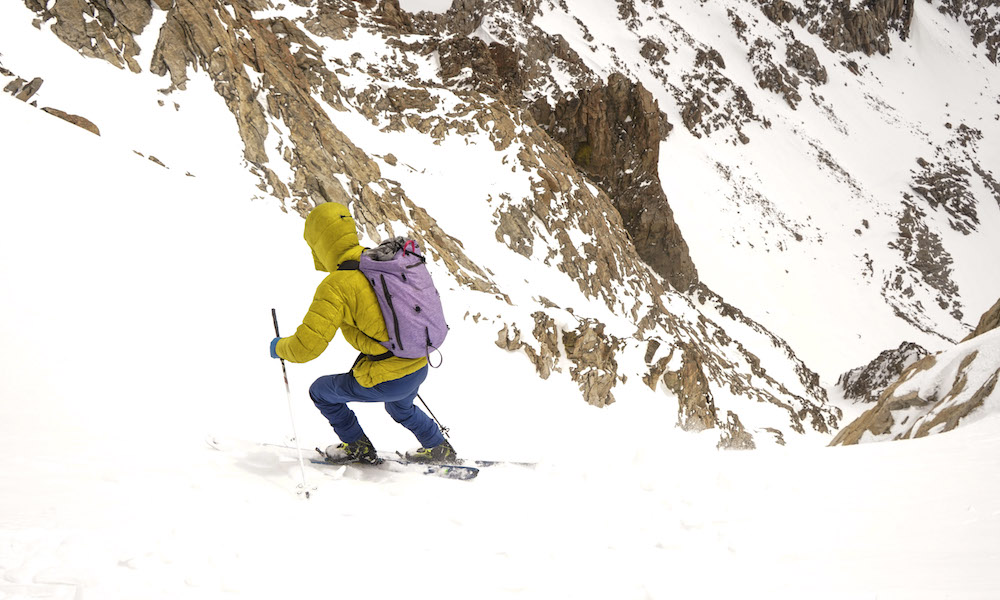
Gavin descends our first line of the trip. Golden granite and variable snow included (Photo: @morgankelsey)
Day 3
With a stronger understanding of the local snowpack, we decided to step out into new terrain to learn more about the area’s conditions. We still approached the day cautiously and curious to gather more information. The morning began with a long breakfast of coffee, oatmeal, coffee, and pancakes. Breakfast was paired with route planning, snack planning, and music shuffling. The plan was to catch the late corn cycle of the [what seemed to be] newly developed freeze-thaw cycle.
Our ski day was spent chasing solar aspects: working from east to south to west. We surfed through long planar runs of immaculate spring snow. Our tour fell into a smooth rhythm of ascending shaded terrain, transitioning atop timely corned snow, slashing through spring surf, refueling with a buffet of various snacks, and repeating the process. At higher elevations the freeze-thaw conditions transitioned into a more complex winter snowpack due to the lower temperatures and increased winds. We sampled a similar aspect and elevation to our desired ski descent on Garnett peak to better assess high mountain conditions. The day finished in a similar format to the last: drying gear, basecamp card games, and high-calorie snacks. Our bodies were feeling the effects of the high-elevation sun, so we spent more time under the protection of our cook tent.
During dinner, we discussed the option of skiing Gannett: What observations do we have to support a safe ski? Do we feel fit/healthy enough for an attempt? Are we psyched? Does our plan give us a comfortable margin of safety? After some post-dinner cookies and tea, we ultimately went to bed with the decision to attempt a ski of Gannett Peak the next day (!).
Day 4
Summit day morning began with a long, flat, cold, dark tour across a frozen lake. It was meditative to fall into a smooth cadence of kicking and gliding. As the angle of the approaching pass increased, our skinning transitioned to bootpacking. I cherished the methodical movement of french stepping up the frozen slope. The morning was quietly unfolding into a soft palette of purple as we plodded up the snowy shoulder. The mountains, the sky, and the entire winter landscape turned a monochromatic tone of purple. An ‘I feel so small’ feeling lit inside me.
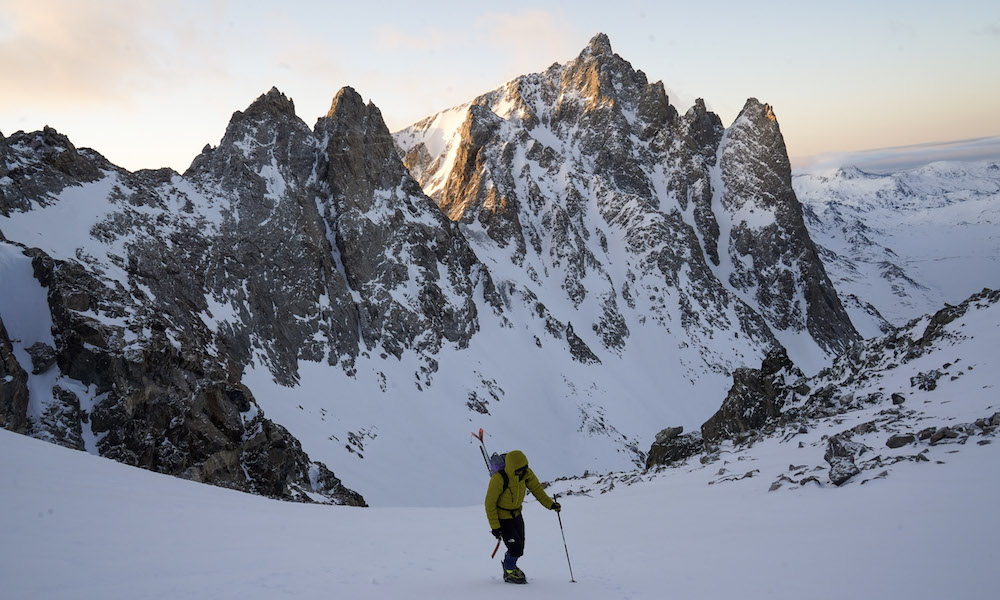
Gavin on the bootpack to the saddle with the first rays of morning light behind him. (Photo: @morgankelsey)
We topped out the pass at sunrise to catch our first sight of Gannett. The basin below was expansive and wild. A surprise was seeing a fresh coat of snow on Gannett. We considered the introduced variability from the new snow: How would our plans change? How did the snowfall affect the snowpack? After some deliberation, we proceeded with caution. As we descended into the basin towards Gannett, the ‘I feel so small’ feeling grew stronger. There was one more uphill transition of skinning to bootpacking where we ascended a couloir and soon reached the summit ridge. A traverse over the notably airy south face led us to Gannet’s summit block. The air was still, the sun was bright, and we were all smiling bright.
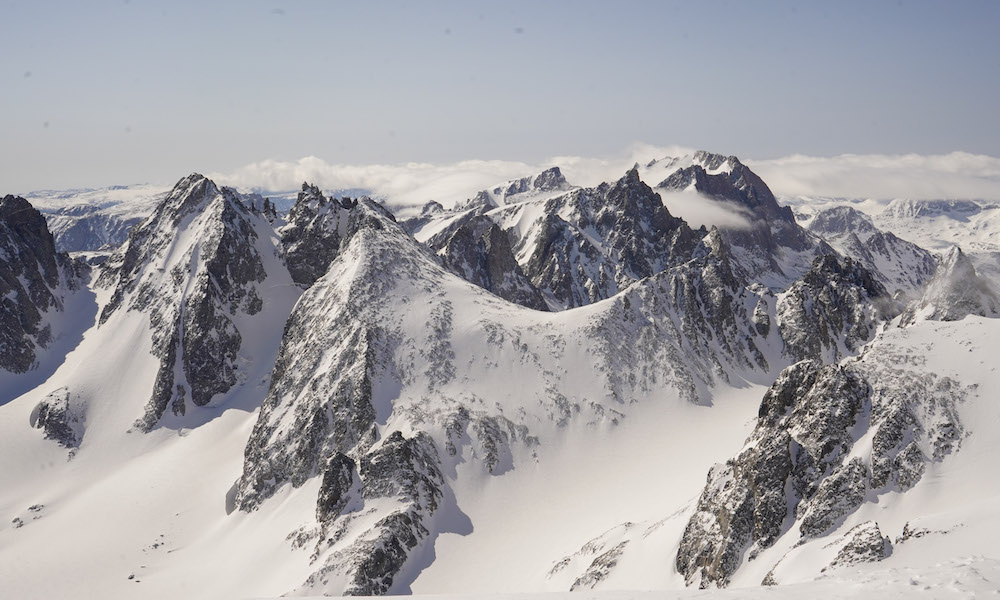
Our view from the summit of Gannett. On Day 1, we skied the broad peak just right of center in the frame. (Photo: @morgankelsey)
This was bliss: exploring new-to-me terrain with high-quality company, ending up on a remote summit, and a technical descent through fresh snow soon to come. I savored our experience for a moment longer before resetting my mindset for the serious descent below.
The fresh snow bonded well and we skied Gannett’s south face in powder. The traverse across the south face was delicate, threading turns through fresh snow while keeping an eye on the rolling edge beneath us. Soon we reached a fault in the cliff band and committed to the abyss below. The pitch steepened and I felt I was skiing the line between the snow and the sky. I planted my poles and precisely pivoted in the air with each calculated turn. Plumes of powder puffed skyward as I drew a line down the face. This skiing was steep, engaging and pure bliss.
I stopped in a safe zone, heart throbbing from joy and high altitude. I radioed up to acknowledge my safety and the condition of the snow. Gavin and Morgan joined me after each drawing their own unique descent down the face. Our climb back over the pass and subsequent spring snow, GS-turn, hooting-and-hollering group descent back to camp was an unexpected finish to our day. We glowed in post-powder euphoria back at camp.
Celebratory quesadillas were in order as the orange afternoon glow filled the surrounding cirque. Our directionless banter carried more electricity that evening. We each stitched together our own play-by-play descriptions of the day: building our individual experiences into a single group memory. The night crept up fast as we sat in the cook tent, savoring the day of skiing, identifying moments when we were most exposed to risk, debriefing on our actions, and feeling thankful for our safe passage. I drifted asleep satiated, mulling over that rich day in the mountains.
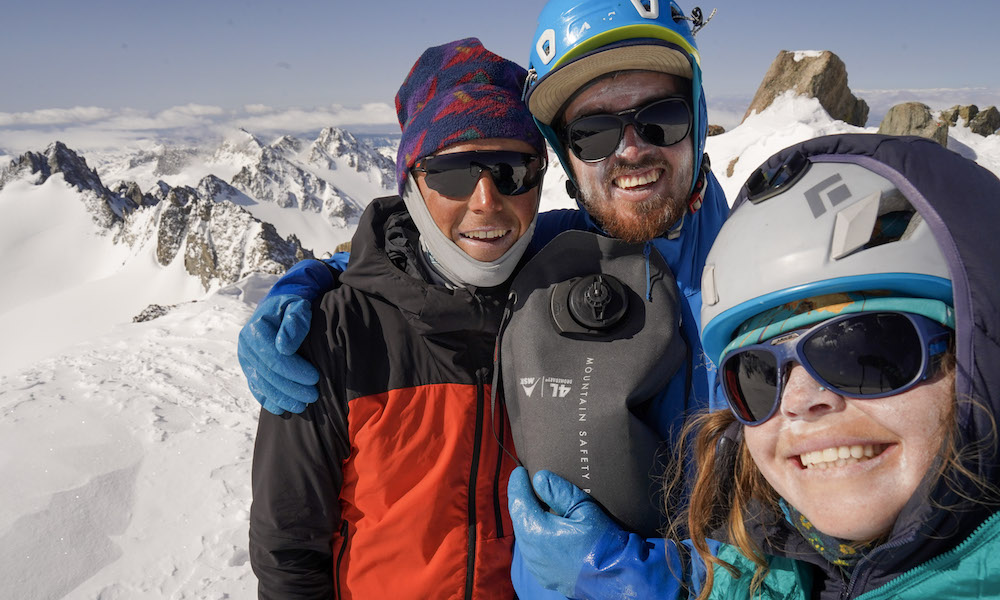
Gavin, Morgan, a full 4L dromedary carried by Gavin, and I on the summit of Gannett. The sun was relentless all week – hence the thick layers of zinc. This was a memory I will never forget: phenomenal friends, lots of water, and stunning alpine terrain. Oh yeah, and fresh snow!
Day 5
A slow day. We engaged in a multiple-coffee breakfast, a spring corn surf day (see Day 3 for similar ski schedule of events), and a few local couloirs that invited us to be skied from our basecamp vantage point.
After five days in the wilderness, completely disconnected, I now felt settled into the pace of backcountry life. Our days transitioned to be measured in distance traveled rather than time passed. The sun moved across the sky and our skis slid up and down the snow. Good company, safe skiing, big country.
Day 6
We dismantled camp and packed our bags. Our sled was substantially lighter without five days worth of food. Aside from our tracks in the snow, we left no trace of camp. All of our trash, along with other garbage which we found during our stay, was packed into the sled. The exit was pleasant and light. We stopped to look back at the mountains and enjoyed the constantly changing view. The range looked less intimidating than it had during our approach.
More Ways How we Reduced the Impact of Our Trip:
— We picked up ALL trash we encountered on our trip and packed it out to dispose of at a municipal trash facility (there was no trash service at the trailhead)
— We stowed away all of our scented items, food, and trash each night as to not attract local wildlife
— We researched beforehand how to minimize our impact in alpine terrain. Here are a few great links:
The Seven Principles of Leave No Trace
Alpine LNT Principles
Local Forest Service Information
LNT Social Media Guidelines
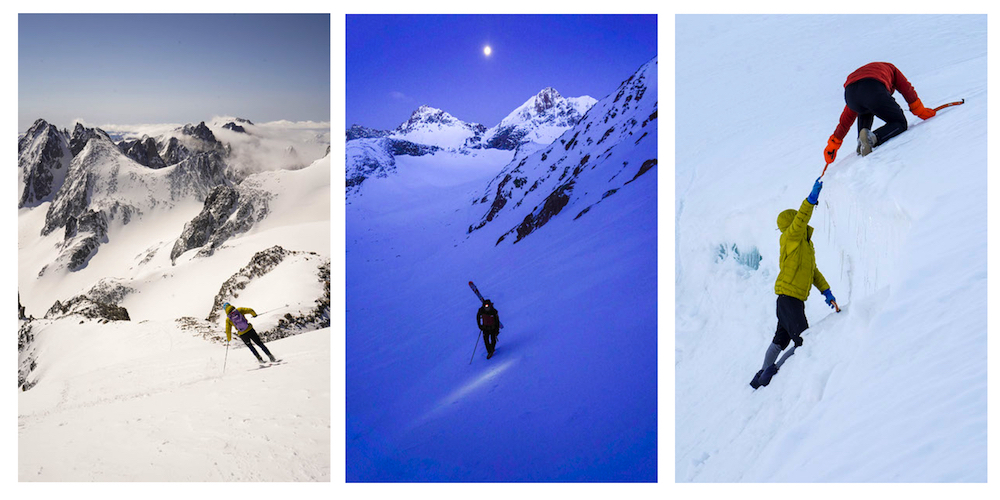
Left Photo: Gavin making the first turns off the summit of Gannett
Center Photo: Slator bootpacking in the Purple Hour at dawn
Right Photo: Jumping the camp cornice wasn’t enough for our last night, we sieged the cornice ground up
Slator Aplin lives in the San Juans. He enjoys time spent in the mountains, pastries paired with coffee, and adventures-gone-wrong. You can often find him outside Telluride’s local bakery — Baked in Telluride.

